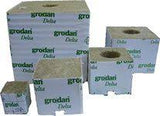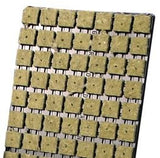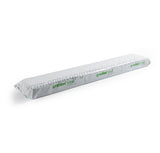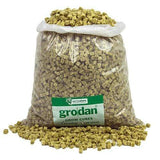GRODAN Rockwool
Grodan Rockwool Cubes 101: The Do’s and Don’ts
Rock wool cubes have become an extremely popular choice as a growing medium. Also referred to as stonewool, rockwool is made from basalt. This growing medium has been used for over 40 years due to its capacity of water-holding, being sterile, and due to its inert capacity.
Do: Fertilise the Rockwool Cubes
When you utilise rockwool cubes, all nutrients have an immediate effect on your plants. Feeding mistakes can also be corrected immediately, which ensures an optimised use of fertiliser. This is possible due to rockwool not looking out any fertiliser, which allows all the nutrients in rockwool to be available in the solution or to be drained out the bottom of the container.
Irrigating with just water will lead to a drop in the fertiliser concentration, which can cause slight shock to your plants. Irrigate less often with a very well-balanced nutrient mix; this is preferable to watering frequently without nutrients.
Do: Pre-Soak the Cubes
Rockwool is shipped dry with 0% water content and the first wetting of the rockwool cubes is essential. To get the most out of rockwool, immerse it in a nutrient solution with a slightly acidic pH 5.5, waiting until all the rising bubbles disappear.
The water will then infiltrate the tiny pores in rockwool and ensure that it’s prepared for roots to develop. Depending on the size of the block to immerse, it might take between a few seconds (for small seed plugs) or several minutes (for large rockwool products).
Make use of the opaque plastic foil covering that rockwool arrives with to pre-soak it, as most rockwool slabs may not fit in tubs or buckets. When this wrap completely encases rockwool, you can fill it with the nutrient solution until completely wet before cutting a drainage slit.
Do: Reuse and Recycle
Initially developed as building insulation, rockwool used in hydroponics has very few properties in common. Insulation material won’t help plants to grow at all, as the building material doesn’t absorb any water. The similarity of these two materials has led to fears over the disposal, reuse, and toxicity of rockwool cubes.
After every plant cycle, rockwool cubes can be reused for different plants. You can also shred it and compost it for reuse in garden beds or potting mixes. Rockwool is basalt, which provides the ideal potted plant amendment as a crushed rock.
You should, however, avoid using rockwool that has been used previously to start plants. Additionally, avoid reusing growing media to repeatedly grow crops within the same botanical family. Treat used rockwool with enzymes to address any rotting roots - our Gold Label Enzyme product is perfect for any growing media and hydroponic system.
Don’t: Squeeze the Cubes
Although a common perception of rockwool cubes says that they need to be squeezed to remove excess water, this isn’t the right thing to do. The fibres’ structure has beneficial properties of water retention and air porosity, allowing the adequate development of root systems.
Should you crush the rockwool cubes, this structure and the air porosity will be damaged and never restored again. Squeezing rockwool too much will leave you with a wet and soggy mess without aeration - so make sure to be delicate with the cubes.
Don’t: Over-stack or Overthink
Rockwool’s porosity and structure will help to determine how tall a container should be. Irrigating from the bottom will cause issues, as water won’t wick up more than half a dozen inches above the surface of the water. This will apply to most growing media - which tends to result in the container soaking wet at the bottom and dry at the top.
An ebb and flow system will likely not be problematic with rockwool stacking, as long as irrigation is done from the top. With all the plant roots at the bottom of the container looking for water, make sure to choose a container that allows for enough root volume, while keeping in mind that water has to travel through a fibre network.
Don’t: Overwater Your Plants
When irrigating the rockwool cubes, make sure to always fertilise them and to allow for drainage to wash off fertiliser excess. Runoff shouldn’t exceed approximately 30% in level, with little water draining from the bottom of the rockwool blocks.
Should the drainage exceed 30%, then you are likely overwatering your plants. Overwatering can lead to algae growth, so make sure to carefully consider how much you water rockwool. Additionally, make sure to not remove the opaque plastic foil to prevent the algae growth. As much as around 85% of water volume in rockwool is available to plants, which will only be in stress after extremely dry rockwool conditions (as low as 10% water).















